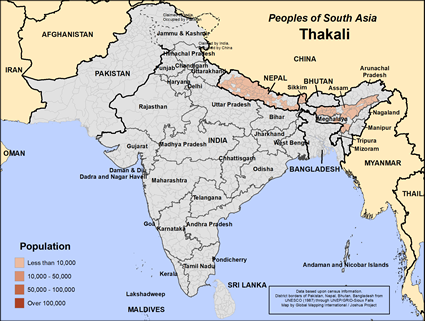Thakali in Nepal

Photo Source:
Anonymous
|

Map Source:
People Group Location: Omid. Other geography / data: GMI. Map Design: Joshua Project
|
| People Name: | Thakali |
| Country: | Nepal |
| 10/40 Window: | Yes |
| Population: | 12,000 |
| World Population: | 14,100 |
| Primary Language: | Nepali |
| Primary Religion: | Hinduism |
| Christian Adherents: | 4.50 % |
| Evangelicals: | 2.25 % |
| Scripture: | Complete Bible |
| Ministry Resources: | Yes |
| Jesus Film: | Yes |
| Audio Recordings: | Yes |
| People Cluster: | South Asia Hindu - other |
| Affinity Bloc: | South Asian Peoples |
| Progress Level: |
|
Introduction / History
The Thakali primarily inhabit the Thak Sat Soe area in Thak Khola in the southern part of the Mustang District. Mustang is located within the Dhawalagiri Zone of northcentral Nepal. Others have spread out into the 'Myagdi, Baglung, Parbat, Kaski, Gulmi, Syangja, Palpa and Rupendehi districts. The thirteen major Thakali villages are spread on the western bank of the Kali Gandaki Gorge through which flows the Kali River.' The Thakali region is spectacular, flanked by the massive Annapurna Himal and the Dhawalagiri Himal, with peaks rising to 8,090 meters (26,535 ft.).
There are four major clan divisions among the Thakali: Chhyoki, Salki, Dhimchen and Bhurki.
Though most live in Nepal, there are some in northern India as well.
What Are Their Lives Like?
Thakali men traditionally obtain their brides by abducting a girl when she is gathering wood in the forest or fetching water from a stream. She is taken back to the boy's home for several days, after which notification is sent to the girl's parents, bidding them to agree to the marriage.
For centuries the Thakali dominated the salt trade of western and central Nepal, trading southward into India and northward into Tibet. This has made them one of the wealthiest groups in Nepal today. Although the Thakali language is part of the Tibeto-Burman language family, they are making a 'conscious effort to dilute their Bhotia [Tibetan] connection. The trend is towards identification with Hindu castes or better-known ethnic groups. '
The present transition of the Thakali culture is also seen in their religion. 'Thak Khola is in the zone where Tibetan cultural influences from the north encounter Hindu cultural influences from the south. Thus, a mixture of native cultural elements and elements brought in and assimilated from the outside can be witnessed.
What Are Their Beliefs?
This syncretism is above all reflected in religion, which is here a combination of animistic, pre-Buddhistic elements joined with Buddhist and Hindu ones. Adherents of Catholicism are now found among the migrated Thakalis and some Thakalis in Kathmandu call themselves atheists.'
What Are Their Needs?
Although the Thakali have been coming under many influences in recent years, Christianity has not been one of them. They remain unreached with the gospel that can liberate them from sin and death.
Prayer Points
Pray for the Thakali people to understand and embrace that Jesus wants to bless their families and neighborhoods.
Pray for Holy Spirit anointed believers from the Thakali people to change their society from within.
Pray for a movement in which the Holy Spirit leads and empowers disciples to make more disciples.
Pray for a movement of Jesus to heal and strengthen Thakali communities.